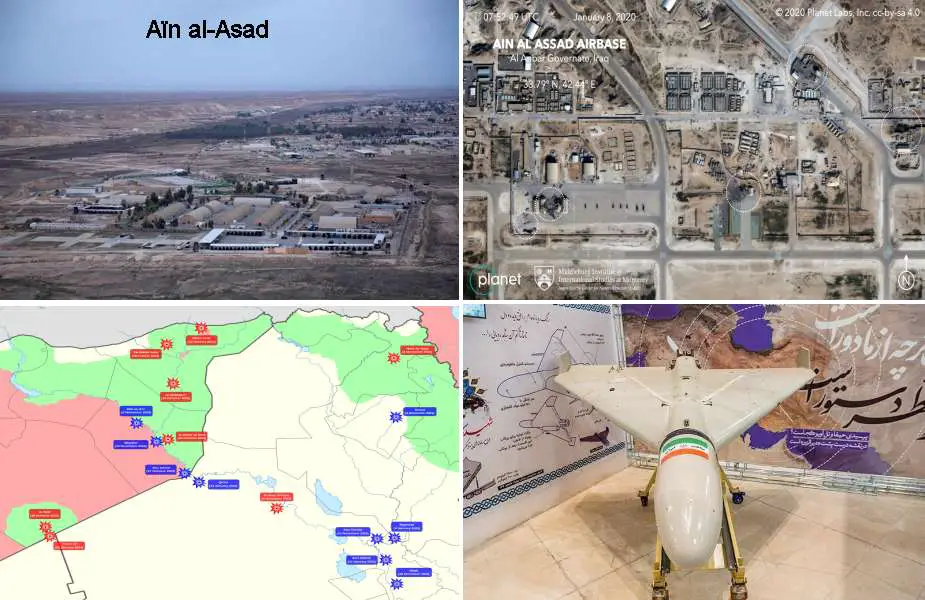Iran-Backed Militias attempt to strike US Ain al-Asad Air Base in Iraq
On April 22, 2024, Ain al-Asad Air Base in Iraq, located approximately 180 kilometers west of Baghdad and hosting U.S. forces, was targeted by a drone attack. This incident marked the first direct targeting of American troops since February of the same year. It stands as the second-largest U.S. Air Force base in Iraq.
Follow Army Recognition on Google News at this link

Ain al-Asad Air Base in Iraq located approximately 180 kilometers west of Baghdad and hosting U.S. forces, was targeted by a drone attack. (Picture source: Wikimedia)
During the attack, two one-way attack drones were intercepted and shot down by the base's defenses. Fortunately, there were no injuries or damage to infrastructure reported following this attempted assault.
Ain al-Asad Air Base is a strategic site for American military operations, particularly in the fight against ISIS through Operation Inherent Resolve. The incident is still under investigation to determine the precise origins of the drones and the motivations behind the attack.
The series of attacks on U.S. military bases in Syria, Iraq, and Jordan began on October 17, 2023, in response to the United States' support for Israel during the Israel-Hamas war. These attacks, coordinated by Iran-backed militias, targeted key locations including the Ain al-Asad Air Base in northern Iraq, the al-Tanf garrison in Syria, and several bases in eastern Syria like the al-Omar oil field and al-Shaddadi. The methods employed in these attacks include drone strikes, ballistic missile attacks, and ground assaults, representing a significant escalation in hostilities affecting U.S. forces in the region.
Ain al-Asad Air Base was the first to experience an intercepted strike. However, subsequent days saw an intensification of attacks, including a ballistic missile strike on November 20, which injured eight American and coalition soldiers and caused minor infrastructural damage. On January 20, 2024, the base was targeted again by about fifteen rockets and ballistic missiles fired by a pro-Iranian group. According to initial reports, thirteen were shot down by air defense systems, and two hit the base, injuring at least one Iraqi soldier.
Another strategically important site, the al-Tanf garrison in Syria, was also frequently targeted. On October 18, 2023, a drone strike attributed to an Iranian proxy group injured more than 20 people. These ongoing attacks against al-Tanf demonstrate the militias' intent to disrupt American military operations and presence in a crucial region for controlling the Syrian-Iraqi borders.
In addition to these bases, oil facilities at al-Omar and al-Shaddadi in eastern Syria, which house U.S. forces, were also attacked by drones. On October 24, 2023, the Islamic Resistance in Iraq claimed responsibility for multiple drone strikes on these sites, highlighting their capability to coordinate operations across multiple fronts.
These continual attacks since October 2023 not only demonstrate the capability and willingness of Iran-backed militias to target U.S. forces but also the high level of tension in the region. The United States has responded with several retaliatory strikes, targeting training facilities and weapon caches of the militias, in hopes of deterring future attacks. However, the complex political and military terrain in Iraq and Syria continues to present significant challenges to American strategy in the region.
Pro-Iranian militias use a variety of drones to carry out attacks on American bases in Iraq, often employing Iranian-manufactured equipment or locally adapted variants. Among the most frequently used drones are:
Ababil: Designed for surveillance and attack missions, the Ababil is capable of carrying small explosive charges and is often used in kamikaze missions, where the drone itself is used as a projectile. This drone is well known for its versatility in various mission types, making it a preferred choice for militias looking to conduct strikes.
Mohajer: Another Iranian creation, the Mohajer drone was initially designed for reconnaissance. Over time, it has been adapted to carry armaments, thereby enabling it to perform strike missions. Used in numerous regional conflicts, the Mohajer has proven its ability to provide essential support in reconnaissance and offensive capabilities to forces aligned with Iran.
Shahed 136: The Shahed series includes several drone models, some used exclusively for surveillance while others are optimized for suicide attacks. Models such as the Shahed-129 and Shahed-136 are particularly notable. The Shahed-136, for example, is a kamikaze-type drone used to perform precise strikes against static targets, demonstrating notable effectiveness in asymmetric warfare contexts.
These drones provide militias with the ability to conduct remote strikes, enhancing their effectiveness while reducing risks to their own forces. The use of these drones illustrates the asymmetric tactics preferred by Iran-backed groups, aiming to inflict maximum strategic impact while minimizing losses among their ranks.
- Hits: 2623
















